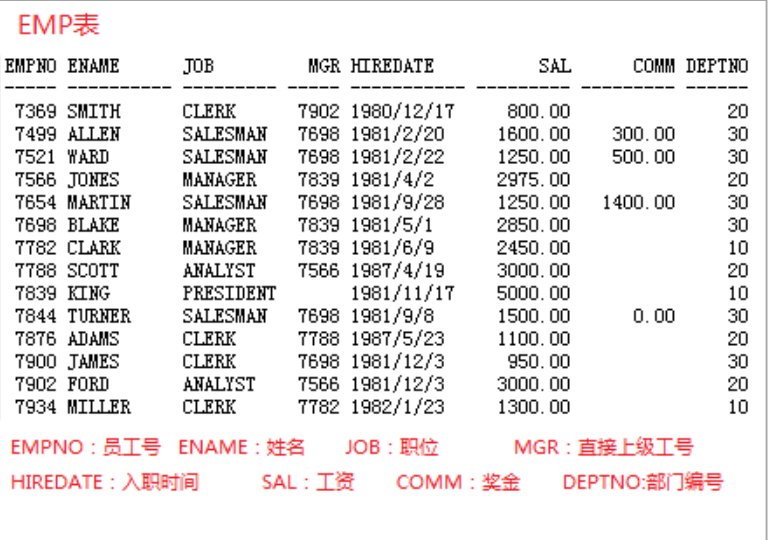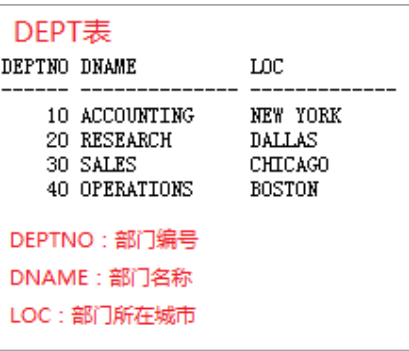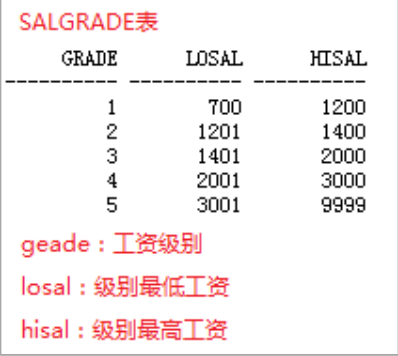Day04- -e Oracle
Day04- -e Oracle 查詢基礎
學習目標:
? 修改數據
? 刪除數據
? 簡單查詢
? 條件查詢
? 分組查詢
e oracle 修改數據
使用 update 語句修改表中數據。
U Ue pdate 語 句基本 語 法:
update 表名 set 列名= = 表達式 [, 列名 2= 表達式 2,...][where 條件 ];
註意事項:
1、update 語法可以用新值更新原有表行中的各列;
2、set 子句指示要修改哪些列和要給予哪些值;
3、where 子句指定應更新哪些行。如沒有 where 子句,則更新所有的行。( ( 特別小心) )
對 students 中的數據進行修改
將張三的性別改成女
SQL>update students set sex=‘女‘ where name=‘張三‘;
把張三的獎學金改為 10
SQL>update students set fellowship=10 where name=‘張三‘;
把所有人的獎金都指高 10%
SQL>update students set fellowship=fellowship*1.1;
將沒有獎學金同學的獎學金改成 10 元
SQL>update students set fellowship=10 where fellowship is null;
特別註意:當修改空記錄時應用 is null 而不能使用=null 或=‘‘
e oracle 表的管理- -- 刪除數據
基本語法:
delete from TABLENAME [where where_definition];
delete from 表名 [where 條件表達式 ];
註意事項:
1、如果不使用 where 子句,將刪除表中所有的數據。(特別註意)
2、delete 語句不能刪除某一列的值(可使用 update)。
3、使用 delete 語句僅刪除記錄,不刪除表本身。如要刪除表,使用 drop table 語句。
4、同 insert 和 update 一樣,從一個表中刪除記錄將引起其它表的參照完整性問題,在修改數據庫數據
時,頭腦中應始終不要忘記這個潛在的問題。
刪除的幾種方法比較:
delete from 表名;
刪除所有記錄,表結構還在,寫日誌,可以恢復的,速度慢
drop table 表名;
刪除表的結構和數據
delete from student where xh=‘A001‘;
刪除一條記錄
truncate table 表名;
刪除表中的所有記錄,表結構還在,不寫日誌,無法找回刪除的記錄,速度快。
設置保存點
savepoint 保存點名稱;
回滾
rollback to 保存點名稱;
合 特別註意:設置保存點及回滾操作是配合 delete 語句使用,用來找回使用 delete 刪除的數據。而通過
truncate 刪除的表數據是無法通過此方法找回的。
建議: :
在使用 delete 刪除表數據前使用 savepoint 設置保存點,防止數據誤刪除。
e oracle 表基本查詢基礎
scott 用戶存在的幾張表(emp,dept,salgrade)為大家演示如何使用 select 語句,select 語
句在軟件編程中非常的有用,希望大家好好的掌握。
1 ).EMP 員工表

2 2 )T DEPT 部門表

3 3 )E SALGRADE 工資級別表

本 基本 select 語句
基本語法:
select [是否剔除重復數據] *|{字段名(列名),字段名 2(列名 2),字段名 3(列名 3)..} from 表名 [where {條
件}];
註意事項:
1、select 指定查詢哪些列的數據;
2、column 指定列名;
3、*代表查詢所有列;
4、from 指定查詢哪張表;
5、distinct 可選,指顯示結果時,是否剔除重復數據;
6、where 條件。
簡單的查詢語句
1) ) 查詢所有列
SQL>select * from 表名;
2) ) 查詢指定列
SQL>select 列 1,列 2,列 3,.. from 表名;
3) ) 如何取消重復行
SQL>select distinct deptno,job from emp;
4)查詢 SMITH 的薪水,工作,所在部門
SQL>select sal,job,deptno from emp where ename=‘SMITH‘;
特別註意:
oracle 對 對 sql 語句不區分大小寫,但對查詢內容區分大小寫。這與 sqlserver 是有區別的,sqlserver
對查詢內容不區分大小寫。
使用算數表達式
1) ) 顯示每個雇員的年工資
SQL>select ename,sal*13+nvl(comm,0)*13 from emp;
2) ) 使用列的別名
SQL>select ename "姓名",sal*13+nvl(comm,0)*13 "年收入" from emp;
SQL>select ename 姓名,sal*13+nvl(comm,0)*13 年收入 from emp;
SQL>select ename as "姓名",sal*13+nvl(comm,0)*13 as "年收入" from emp;
特別註意:
oracle 在使用別名時,可以用雙引號或不使用或使用 as 來表明別名。但不能使用單引號。sqlserver
是可以使用雙引號、單引號。
理 如何處理 null 值
nvl 函數: :oracle 提供的函數,是用於處理 null 值使用的。
例子:查詢年薪
SQL>select ename,sal*13+nvl(comm,0)*13 from emp;
nvl(值 1,值 2) 解釋:nvl 值 1 為 null 時則取值 2,值 1 不為 null 時則取值 1 原值。
如何連接字符串(||)
在查詢的時候,希望把多列內容做為一列內容返回可以使用|| 連接符。
例子:查詢年薪
SQL>select ename ||‘年收入‘||(sal*13+nvl(comm,0)*13) "雇員的年收入" from emp;
用 使用 where 子句
1) )於 如何顯示工資高於 3000 的員工
SQL>select ename,sal from emp where sal>3000;
2) )找 如何查找 1982.1.1 後入職的員工
SQL>select ename,hiredate from emp where hiredate>‘1-1 月-82‘;
也可以使用 to_char 函數轉換日期類型後再進行日期比較,如下:
SQL>select ename,hiredate from emp where to_char(hiredate,‘yyyy-mm-dd‘)>‘1982-1-1‘;
字符對比還是有一定出入的。不推薦使用。
3) )在 如何顯示工資在 2000 到 到 2500 的員工情況
SQL>select * from emp where sal>=2000 and sal<=2500;
SQL>select * from emp where sal between 2000 and 2500;
說明: between 是指定區間內取值,如:between 2000 and 2500,取 2000 至 2500 內的值,同時包含
2000 和 2500
用 如何使用 like 操作符
%:表示任意 0 到多個字符
_:表示任意單個字符
1 )如何顯示首字符為 S 的員工姓名和工資
SQL>select ename,sal from emp where ename like ‘S%‘;
2 )如何顯示第三個字符為大寫 O 的所有員工的姓名和工資
SQL>select ename,sal from emp where ename link ‘__O%‘;
在 在 where 條件中使用 in
示 如何顯示 empno 為 為 123,345,800... 的雇員情況
SQL>select * from emp where empno=123 or empno=345 or emp=800;
SQL>select * from emp where empno in(123,345,800);
用 使用 is null 的操作符
如何顯示沒有上級的雇員的情況
SQL>select * from emp where mgr is null;
使用邏輯操作符號
於 查詢工資高於 500 或是崗位為 manager 的雇員,同時還要滿足他們的姓名首寫字母為大寫的 J
SQL>select * from emp where (sal>500 or job=‘MANAGER‘) and (ename like ‘J%‘);
用 使用 order by 子句
1) ) 如何按照工資的從低到高的順序顯示雇員的信息
SQL>select * from emp order by sal asc;
註意:asc 寫或不寫都是升序排序即從小到大排序,desc 則是降序排序從大到小排序。
2) ) 按照部門號升序而雇員的入職時間降序排列
SQL>select * from emp order by deptno,hiredate desc;
3) ) 使用列的別名排序
SQL>select ename,sal*12 "年薪" from emp order by "年薪" asc;
別名需要使用“”號圈中。
O O racle 分組查詢
在實際應用中經常需要執行復雜的數據統計,經常需要顯示多張表的數據;要用到分
組函數 max,min,avg,sum,count。
Max(),min() 最大最小
如何顯示所有員工中最高工資和最低工資
SQL>select max(sal) "最高工資",min(sal) "最低工資" from emp;
請查詢最高年工資
SQL>select max(sal*13+nvl(comm,0)*13) "最高年工資",min(sal*13+nvl(comm,0)*13) "最低年工資" from
emp;
Avg() 求平均
顯示所有員工的平均工資和工資總和
SQL>select avg(sal) "平均工資",sum(sal) "工資總和" from emp;
特別註意:
avg(sal)不會把 sal 為 null 的行進行統計,因此我們要註意,如果,你希望為空值也考慮,則我們可以
這樣做
SQL>selec sum(sal)/count(*) from emp;
count(*) 求總數
計算共有多少員工
SQL>select count(*) "共有員工" from emp;
練習題: :
請顯示工資最高的員工的名字,工作崗位
SQL>select ename,job from emp where sal=(select max(sal) from emp);
特別註意:select 語句執行的順序是從右向左執行,正好和書寫的方式相反。
SQL>select ename,job from emp where sal=(select max(sal) from emp);
oracle 會先執行 select max(sal) from emp 這個語句,得出最大工資後。再執行 where 條件前的語句。
請顯示工資高於平均工資的員工信息
SQL>select * from emp where sal>(select avg(sal) from emp);
SQL>select * from emp where sal>(select sum(sal)/count(*) from emp);
group by 和 和 having 子句
group by :用於對查詢的結果分組統計;
g having 子句:用於限制( ( 過濾) ) 分組顯示結果。
1)如何顯示每個部門的平均工資和最高工資
SQL>select avg(sal) "平均工資",max(sal) "最高工資",deptno "部門編號" from emp group by deptno;
2)顯示每個部門的每種崗位的平均工資和最低工資
SQL>select avg(sal) "平均工資",min(sal) "最低工資",job "職位",deptno "部門編號" from emp group by
deptno,job order by deptno;
3)顯示部門平均工資低於 2000 的部門號和它的平均工資
SQL>select avg(sal) "平均工資",deptno "部門編號" from emp group by deptno having avg(sal)<2000;
對數據分組的總結:
1、分組函數(avg...)只能出現在選擇列表、having、order by 子句中;
2、如果在 select 語句中同時包含有 group by/having/order by 那麽他們的順序是 group by/having/order
by;
3、在選擇列中如果有列、表達式和分組函數,那麽這些列和表達式必需有一個出現在 group by 子句
中,否則會出錯。
如 select deptno,avg(sal),max(sal) from emp group by deptno having avg(sal)<2000;
這裏 deptno 就一定要出現在 group by 中。
Day04- -e Oracle
